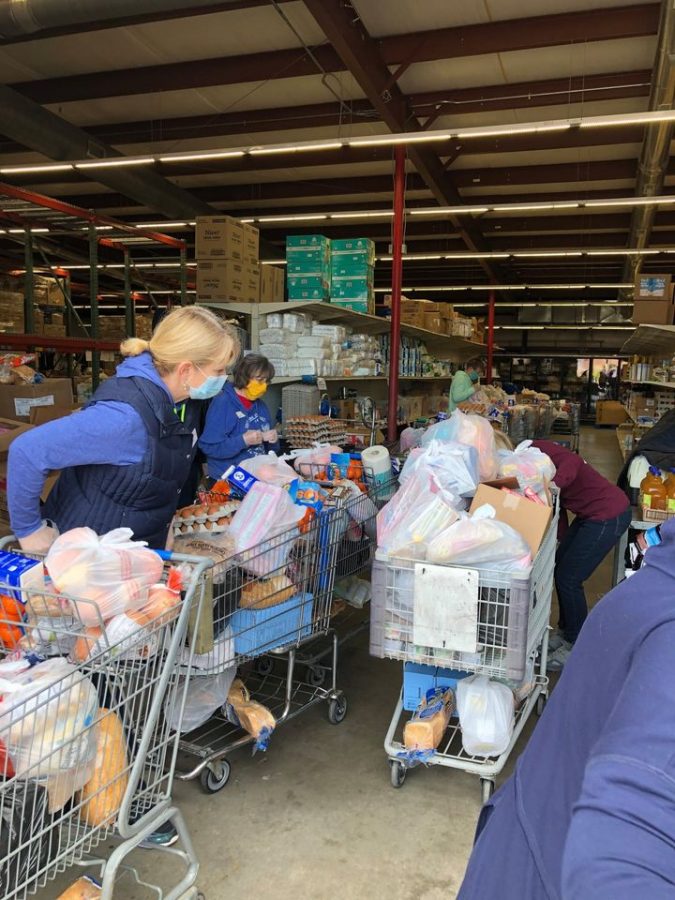Offering Help for Hunger
Least of These has been dishing out support amid the COVID-19 crisis
Least of These volunteers quickly bag and load groceries to feed those with food insecurity during the COVID-19 pandemic.
March 1, 2021
While the COVID-19 pandemic has wreaked havoc on the world, the United States and Christian County. Despite these setbacks, there are groups and organizations in the community willing to help those in need.
When the pandemic first started, millions of people were furloughed or laid-off. Locally, there are still large numbers of adults who have struggled to find a sustainable and well-paying job. This struggle has led to a loss of money which makes resources such as food or even housing unavailable.
Least of These is a food pantry in Christian County that has helped the community for years. Michelle Teter, the development and marketing coordinator of Least of These, says their overall mission is to alleviate food insecurity.
“Least Of These is the only full-service food pantry in Christian County,” Teter said. “Monthly, we provide five through seven days worth of supplemental food to families facing food insecurity and helps these families access healthy food. We are a ‘choice’ food pantry, so clients pick the items they want, eliminating waste and affirming their human dignity.”
Although they mainly combat food insecurity, few people know what that definition means.
“At times during the year, these households were uncertain of having, or unable to acquire, enough food to meet the needs of all their members because they had insufficient money or other resources for food,” Teter said.
COVID-19 has increased this problem in the community.
“We are currently seeing a 32 percent increase in new families coming to Least Of These since COVID-19 started and a lot of situational poverty,” Teter said. “A normal middle-class family could’ve been affected by a loss of a job, so they don’t have as much money as they previously did to pay the bills and provide food for their family. We can help with the food side, so they can pay their heat bill.”
According to a Household Pulse survey taken over Jan. 20 through Feb. 1, 24 million adults, or 11 percent, sometimes or often didn’t have enough to eat. In comparison, a study from the Agriculture Department found that in 2019, only 3.4 percent of adults had this same problem. That is a significant increase in only two years.
Increased demand can be seen in the numbers as well.
“In 2020, we served 10,687 families,” Teter said. “We also saw higher numbers coming to us for food assistance towards the end of the year and in March and April; 37,375 mouths were fed in 2020 and 1,683,367 pounds of food were distributed. In 2019 we hit one million pounds of food distributed, and by May of 2020, we surpassed the number of pounds distributed by 64 percent.”
Although Least of These had many triumphs in 2020, it also had its own struggles.
“When the lockdown happened, even we had problems accessing certain food items,” Teter said. “At one point it was hard to find canned vegetables. We give out a lot of canned goods and perishable food items because sometimes the people who come to us are homeless and that is the easiest food for them to fix or eat. Our operations manager started planning ahead and ordering to have a three-month supply of food in our warehouse in case there is another lockdown.”
They have been working hard to keep the organization intact.
“We want to be welcoming to a new client seeking food assistance and make them feel comfortable in a stressful situation,” Teter said. “They visit us monthly, and we provide them with approximately 50 meals. We provide milk, dairy items, produce, meats and proteins. Convoy of Hope started donating to us on a regular basis when COVID started, and they donated food like candy, chips, Clif Bars and Mac N’ Cheese microwave cups — stuff that kids and teenagers like to snack on when they are home.”
Many food banks had to close down at the beginning of the pandemic. However, Least of These stayed functioning.
“I participated in an online class over the summer with the University of Missouri Extension,” Teter said. “Thirty percent of food pantries in the class had to close at one point during COVID due to lack of volunteers to help or lack of funding to provide food. We wanted to do everything we can to remain open to serve the most vulnerable during the pandemic who need our help.”
People face a stigma when looking for help with food.
“Nobody wants to come to a food pantry,” Teter said. “I’ve seen several different reactions when a new person comes to us the first time for help. They’re all nervous and don’t want to be there or they start crying because they are overwhelmed by the generosity.”
This generosity is cherished in a time of need.
“Last week, a current client drove a new client to her appointment to help her navigate the process and help her out,” Teter said. “I handed her the food sheet so she could select her February food and I gave her a $10 gas card. She started crying. She said, ‘I can’t believe everything you all are doing for me. You have no idea how much this helps me. I wish I wasn’t here but am thankful for your help.’ Seeing the client’s reaction solidifies why we do what we do at Least Of These. Providing food assistance and resources does truly help people in their time of need.”







